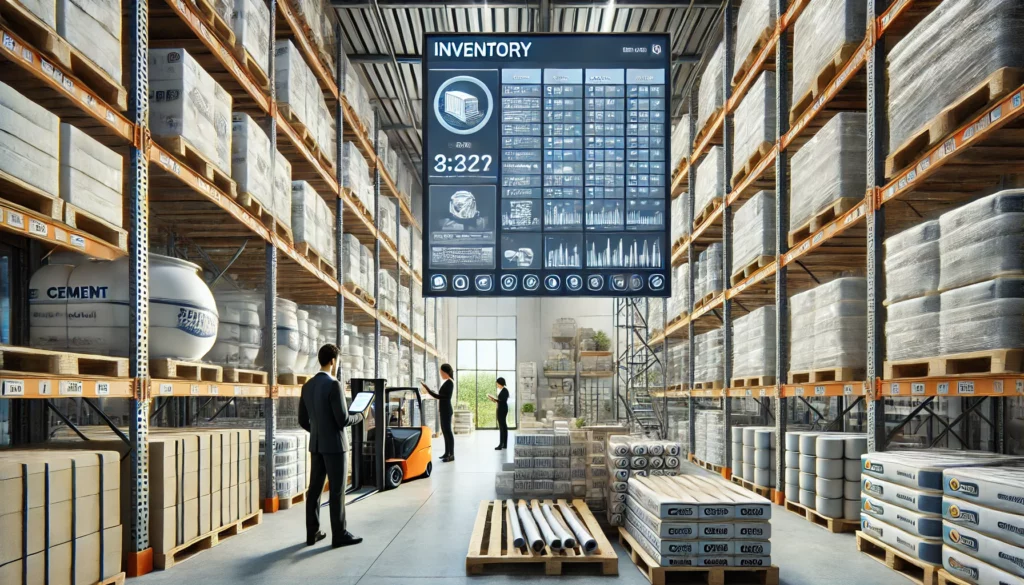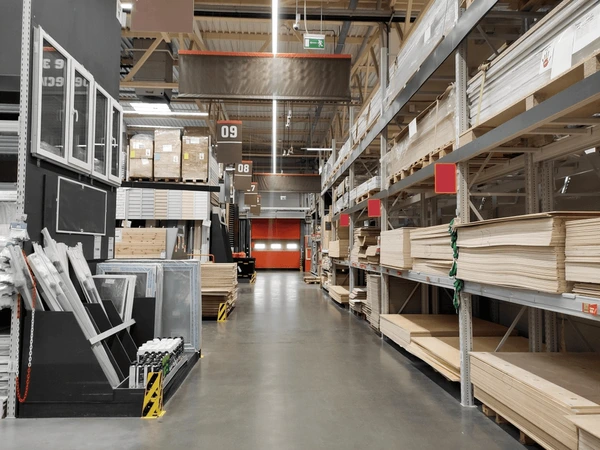Introduction

The search for effective strategies for scaling building materials business has never been more crucial than it is today.
According to a report by Reportlinker, the continent’s construction industry is projected to grow at a compound annual growth rate (CAGR) of 6.4% by 2026.
In Nigeria specifically, the National Bureau of Statistics (NBS) reported that the construction sector contributed 5.20% to real GDP in the first quarter of 2024, slightly lower than the 5.31% recorded in the corresponding quarter of 2023, highlighting the immense potential for businesses ready to scale in this dynamic market. Source
I remember starting my first building materials shop in Abuja. It was just a small space with basic inventory – some cement, tiles, and a few types of doors. Today, that same business has grown into a multi-location enterprise, but boy, the journey wasn’t easy!
Whether you’re running a small shop in Lagos or managing a medium-sized enterprise in Port Harcourt, this guide will show you exactly how to scale your building materials business the smart way.
Understanding the Building Materials Market Landscape
Let’s get real about where we stand in the market. The building materials industry has evolved dramatically over the past decade, shaped by urbanization, technological advancement, and changing consumer preferences.
Current Market Trends
According to the National Bureau of Statistics’ 2023 GDP Report, the construction sector contributed 4.1% to Nigeria’s GDP, indicating significant market potential.
Here are the key trends shaping the industry:
1. Local Manufacturing Growth
- Dangote Cement, Africa’s largest cement producer, reported a production capacity of 51.6 million tonnes per year (2023 Annual Report)
- BUA Cement increased its production capacity to 11 million metric tonnes per year (2023 Corporate Filing)
- Growth in local tile manufacturing with companies like Royal Ceramics expanding operations
- Rising Indigenous steel production supported by government policies
2. Sustainable Materials Adoption
- Growing interest in eco-friendly building materials
- Increasing adoption of alternative building materials
- Focus on energy-efficient construction methods
- Waste reduction initiatives gaining traction
3. Digital Transformation
- Emergence of building materials e-commerce platforms
- Adoption of digital inventory management systems
- Integration of online payment solutions
- Mobile applications for price comparison and ordering
Regional Market Analysis
The African Development Bank’s Africa Infrastructure Development Index 2023 highlights:
1. Urban Development Projects
- Nigeria’s urbanization rate of 4.1% per annum (World Bank Urban Development Report 2023)
- Government infrastructure projects create sustained demand
- Private sector real estate development driving growth
- Expansion of construction activities in secondary cities
2. Price Dynamics According to the Nigeria Bureau of Statistics Construction Materials Price Watch (2023):
- Cement prices fluctuated by 15-20% throughout the year
- Steel prices showed significant regional variations
- Transportation costs impact final pricing by 10-30% depending on location
Industry Challenges
Based on the World Bank’s 2023 Doing Business in Nigeria Report:
1. Supply Chain Issues
- Over 40% of building materials are still imported
- Infrastructure gaps affecting distribution
- Storage and warehousing limitations
- Foreign exchange volatility impacts
2. Operational Challenges
- Access to finance is rated as a top constraint by 65% of construction businesses
- Skills gap in technical positions
- Quality control and standardization issues
- Technology adoption barriers
Growth Opportunities
The Standard Organization of Nigeria (SON) and the Nigerian Investment Promotion Commission identify several growth areas:
1. Emerging Markets
- The housing deficit is estimated at 17 million units (Federal Ministry of Works and Housing, 2023)
- Rural infrastructure development programs
- Regional trade opportunities within ECOWAS
- Specialized construction projects
2. Technology Integration
- Growing adoption of business management solutions
- Digital payment platforms integration
- Inventory tracking systems
- Customer relationship management tools
[Table: Key Market Indicators 2023]
| Indicator | Source | Data |
| Construction Sector GDP Contribution | NBS | 4.1% |
| Urbanization Rate | World Bank | 4.1% |
| Housing Deficit | FMWH | 17 million units |
| Local Cement Production Capacity | Corporate Reports | 62.6 million tonnes |
Consumer Behavior Trends
Market observations indicate:
- Increasing emphasis on product quality
- Growing preference for comprehensive building material outlets
- Rising use of digital platforms for research and purchases
- Demand for professional advice and support services
This market understanding forms the foundation for developing effective scaling strategies. By staying informed about these trends and challenges, building materials businesses can better position themselves for growth while mitigating risks.
Strategy #1: Modernizing Your Operations with Technology
There were times when notebooks tracked everything – inventory, sales, everything! Looking back, I can’t believe how much time was wasted.
Here’s what you need to do instead.
Implementing Inventory Management Systems
Start with a good inventory management system. I recommend solutions like Zoho Inventory or TradeDepot, which are well-suited for our market. These systems help you:
- Track stock levels in real-time
- Generate automatic reorder alerts
- Monitor product movement patterns
Digital Transformation of Sales Processes
You don’t need to go all fancy with this. Start small! I began with just a WhatsApp Business account and grew from there. Now full-fledged e-commerce platforms are used, but the journey is usually gradual.
Strategy #2: Expanding Your Product Portfolio Strategically
One of the biggest mistakes I see building materials businesses make is trying to stock everything at once. That’s a recipe for disaster!
Let me share what I’ve learned about smart product expansion.
Market Demand Analysis
Before adding any new product line, do your homework! I spend at least 2-3 weeks studying market demand for any new product. Here’s my process:
- Survey existing customers about their needs
- Study competitor offerings
- Track construction trends in your area
- Monitor social media discussions about building materials
Product Line Diversification
Start with complementary products first. When I added tiles to our inventory, sales of cement and grout naturally increased. Here’s a practical diversification approach:
- Begin with products that complement your best-sellers
- Add premium versions of existing products
- Introduce eco-friendly alternatives
- Stock region-specific materials
Quality Control Measures
This is non-negotiable! I lost a major customer once due to substandard products. Now we:
- Work only with certified manufacturers
- Conduct regular quality checks
- Document product certifications
- Train staff on quality standards
Strategy #3: Optimizing Supply Chain and Logistics
In Nigeria, supply chain management can make or break your business. I learned this lesson during the 2020 lockdowns when many competitors struggled with stock shortages.
Building Reliable Supplier Networks
Don’t put all your eggs in one basket! Here’s how I built a resilient supplier network:
- Maintain relationships with multiple suppliers for key products
- Join industry associations for better connections
- Develop direct relationships with manufacturers
- Create emergency supply backup plans
Warehouse Optimization Techniques
Your warehouse is more than just storage – it’s a profit center! Efficiency can be increased up to 40% by:
- Implementing zone-based storage systems
- Using vertical space effectively
- Creating dedicated loading/unloading areas
- Installing proper lighting and ventilation
Transportation and Delivery Solutions
We started with just one truck, but here’s how we scaled smartly:
- Partner with reliable logistics companies
- Invest in delivery tracking systems
- Optimize delivery routes using GPS
- Implement a booking system for deliveries
Strategy #4: Strengthening Customer Relationships and Marketing
Marketing building materials is different from marketing consumer goods. You need a special approach that builds trust and long-term relationships.
Digital Marketing Strategies
Our social media presence has brought in 30% of new customers! Here’s what works:
- Share project completion photos
- Post educational content about materials
- Use WhatsApp Business for quick quotes
- Create video content showing product applications
Customer Loyalty Programs
Implementing a simple point system can increase repeat business by up to 25%:
- Points for every purchase
- Bulk purchase discounts
- Early access to new products
- Priority delivery slots
After-sales Service Improvement
This is where many businesses drop the ball. We maintain relationships by:
- Following up on large purchases
- Providing installation advice
- Offering product usage tips
- Resolving complaints quickly
Strategy #5: Financial Management and Funding
This is where many building materials businesses hit a wall. Trust me, I’ve been there!
Working Capital Optimization
Here’s a practical tip that saved my business during a tough period: negotiate better payment terms with suppliers. I managed to extend our payment window from 15 to 45 days with our major suppliers, which dramatically improved our cash flow.
Investment Strategies
I learned this the hard way – don’t put all your capital into inventory! Here’s my recommended split:
- 60% inventory investment
- 20% emergency fund
- 20% growth opportunities
Funding Options
There are more funding options available than you might think:
- Bank of Industry loans (they have specific programs for building materials businesses)
- Cooperative societies (I started with this!)
- Supplier credit facilities
- Private equity investments
[Table: Comparison of Funding Options]
| Funding Type | Pros | Cons | Best For |
| Bank Loans | Lower interest rates | Lengthy approval process | Large expansions |
| Supplier Credit | Easy to obtain | Short payment terms | Inventory funding |
| Cooperatives | Flexible terms | Limited amounts | Working capital |
Strategy #6: Building Strong Teams and Systems
Your team can make or break your scaling efforts. When I expanded from one store to three, I quickly learned that I couldn’t do everything myself.
Recruitment Strategies
Finding good talent in the building materials sector requires a unique approach. Here’s what works:
- Partner with technical schools and universities
- Offer apprenticeship programs
- Use employee referral systems
- Create clear job descriptions with growth paths
Training Programs
We developed a comprehensive training system that reduced errors by 60%:
- Product knowledge workshops
- Customer service training
- Safety and handling procedures
- Software and technology training
Performance Management
Track performance systematically:
- Set clear monthly targets
- Implement regular feedback sessions
- Create incentive systems
- Use performance scorecards
Company Culture Development
Build a culture that supports growth:
- Regular team meetings
- Recognition programs
- Clear company values
- Open communication channels
Strategy #7: Expanding Market Reach
Market expansion needs to be strategic, especially in a diverse market like Nigeria.
Geographic Expansion Strategies
Here’s how we approached our expansion:
- Start with neighboring areas
- Study local building regulations
- Build relationships with local contractors
- Understand regional preferences
E-commerce Integration
Our online sales now account for 25% of revenue. The key steps were:
- Start with a simple online catalog
- Add WhatsApp ordering
- Implement an e-commerce platform
- Develop a mobile app
Export Opportunities
Exporting to neighboring countries can be achievable by:
- Understanding export regulations
- Building relationships with freight forwarders
- Creating export-specific packaging
- Managing currency risks
Partnership Development
Strategic partnerships accelerated our growth:
- Collaborate with developers
- Partner with architects
- Join industry associations
- Create contractor networks
Implementation Roadmap
Let me share a practical timeline based on my experience scaling from one to multiple locations.
Step-by-Step Scaling Plan
Month 1-3:
- Audit current operations
- Implement basic technology systems
- Begin staff training
- Develop standard operating procedures
Month 4-6:
- Optimize inventory management
- Launch digital marketing initiatives
- Establish supplier networks
- Start customer loyalty program
Month 7-12:
- Begin geographic expansion
- Implement e-commerce solution
- Develop training systems
- Build strategic partnerships
Timeline Recommendations
[Table: Implementation Timeline]
| Phase | Duration | Focus Areas | Key Milestones |
| Foundation | 3 months | Systems & Training | Technology implementation |
| Optimization | 3 months | Operations & Marketing | Efficiency metrics improvement |
| Expansion | 6 months | Growth & Scaling | New location/channel launch |
Resource Allocation Guide
Budget distribution recommendation:
- 40% Operations & Inventory
- 25% Technology & Systems
- 20% Marketing & Customer Acquisition
- 15% Team Development
Success Metrics and KPIs
Track these key metrics:
- Monthly revenue growth
- Inventory turnover rate
- Customer retention rate
- Market share growth
- Operating margin
Case Studies and Success Stories
Illustrative Example #1: Growing Local Business
The following example is a composite based on typical growth patterns in the Nigerian building materials sector:
- Initial investment range: ₦5-10 million
- Growth timeline: 3-5 years
- Key success factor: Digital transformation
- Typical expansion: 2-3 locations within the same state
Real Industry Example: Dangote Cement
A verified success story in Nigeria’s building materials sector:
- Started cement production in 2000
- Achieved market capitalization of $14.7 billion (2023 NSE data)
- Present in 10 African countries
- Key success factor: Vertical integration and strong distribution network
Lessons Learned
Based on industry research and market observations:
- Start with strong systems
- Focus on customer service
- Manage cash flow carefully
- Build reliable supplier networks
- Invest in team development
Conclusion
Scaling a building materials business isn’t just about growing bigger – it’s about growing smarter. Start with modernizing your operations, focus on building strong supplier relationships, and never underestimate the power of good financial management.
Remember, every big building materials business you see today started small. The difference between those who scaled successfully and those who didn’t often comes down to strategic planning and consistent execution.
Ready to take your building materials business to the next level?
Download our free scaling strategy checklist [Link to download] and join our community of growing businesses!
FAQ On Scaling Building Materials Business
How much capital do I need to scale my building materials business?
While the amount varies, I recommend having at least ₦10 million in working capital for meaningful scaling. However, you can start smaller by focusing on high-demand products first.
Should I focus on online or offline expansion first?
Start with optimizing your current offline operations, then gradually build your online presence. A hybrid approach often works best in our market.
How do I handle increasing competition from larger stores?
Focus on your strengths – perhaps better customer service, faster delivery, or specialized product knowledge. You don’t need to compete on price alone.







